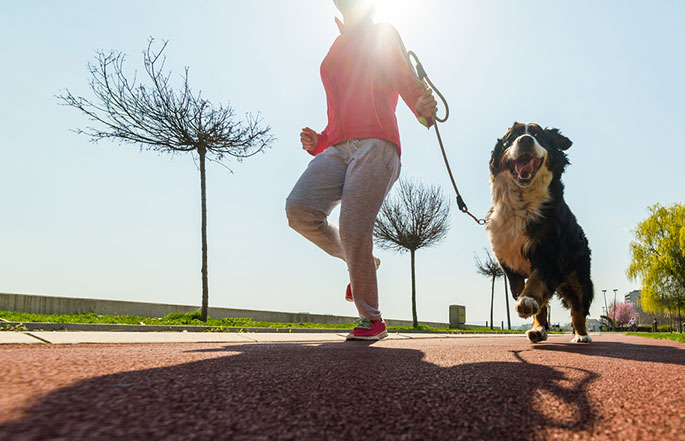
Dogs, just like humans, need to exercise so that they can be fit and healthy. If you love your daily run, you can invite your pet to accompany you on certain occasions. But before you do that, you should know more about your dog’s breed so that you understand the level of running he or she may enjoy. You can be glad to discover that you have a pet that can be the inspiration you need to take part in a marathon.
Read More:
- how to start running with your dog
- Odds of Finding Lost Dogs: Will You Ever See Your Buddy Again?
- Best Dog Exercise That Works Well To Develop Them
- 4 Reasons to Consider Starting Your Own Dog Park
- How To Make Sure Your Dog Is Always Safe
- Why You Should Start Working Out With Your Dog
Why Run With Your Dog?
Running is good for your health; there is a lot of research to support this statement. It helps you maintain healthy body weight, to stay fit, and avoid various health issues. When your running regularly you increase your stamina. It can also help you be in better moods.
If going for a run is good for you, then it also is ideal for your dog. It will help them with the same issues of health as you – maintaining the right body weight, building muscles, and increasing stamina as well as aid your pet be in a temperate mood. Overall, running with your dog will help reduce the visits to the bet. Overall, dogs are built to run, some more than others. However, they all enjoy the outdoors, the smells, sights, and sounds.
If you have seen some undesirable changes in your pet’s behavior, then you might address this by taking him or her with you for your jog or run. Dogs are social, and they benefit more from being active. For the highly active breeds, keeping them indoors will affect them emotionally as they become bored and annoyed. Therefore, by keeping their mind and body active, you will be helping them unleash any pent-up energy. Running with your dog will also be an ideal way of building a strong bond between the two of you.
How To Train Your Dog To Run With You
When it comes to running with dogs, there is no specific schedule that you can follow. The best approach is to tailor the exercise to suit both of you as you take into account your needs, capabilities, as well as those of your pet. Get yourself some comfortable shoes from Orthotic Shop and start to run with your dog. Take things slowly and gradually build upon your achievements. Check with your dog’s vet before you decide to use any exercise regime. Your canine should not have any pre-existing health issues that can be exacerbated by running. That means that you only need to let your dog run for a long as he or she as the natural stamina for such an activity.
- Start with a short run or job in an area the dog knows.
- Increase the distance over the weeks the follow.
- Panting should not be a concern, but your dog should not get winded during the runs.
- Remember that you are the alphas and your pet should listen to your commands; therefore, do not be out of breath to the point where you cannot issue a command clearly.
How To Run With A Lead
During the first few sessions, you should have your dog on a leash during the runs so that it is within a safe distance from you. Expect him or her to get excited and want to pull ahead or lag behind you, but with will change as the dog learns the expected routine. On your side, be patient and allow both you and your canine companion to acclimatize to each other’s running patterns.
When putting your dog on the leash, start with taking your pet for a walk to help him or she gets accustomed to the strap. Do not opt to use the retractable leashes and what you pick should leave a space of about 3 – 6 feet between you and the dog so that he feels free.
How Age And Breed Affects The Run
Different dog breeds are naturally conditioned for certain things. Some may be excellent runners, yet their build may not necessarily correlate with such a thing. For instance, the Person Russell terrier is a relatively small breed of dog, but it also is a steady runner that can cover miles compared to the leggy Greyhound that will cover short distances. The Greyhound is therefore perfect for sharp sprints and not the long runs. Consequently, you should take the time to research your running partner so that you are confident that your pet will enjoy the exercise.
Exercise a bit of caution with your pet. If the dog is still a young pup, do not mistake its upbeat personality to mean that it can accompany you for your runs. Wait until your pet is fully grown. In the case of aging dogs, they may still want to enjoy the outdoors, but they will tire quickly compared to younger canines.
Top Tips For Running With A Dog To Remember
- Stay alert: Your pet will not tell you that it is tired or feeling unwell. You, therefore, should know how to read the unspoken signs before, during, and after the exercise.
- Drink lots: Your pet and you should be well hydrated before you go for the run. Dogs tend to get dehydrated quickly, and this leads to rapid exhaustion. Carry a water bottle if you will cover a long distance.
- Take care: After the run, take the time to clean your pet’s paws. Use that time to check for any scrapes or cuts and treat them to prevent infections.
- Choose carefully: Take into consideration the surroundings of the routes your pick so that both you and your pet can enjoy the time spent exercising together. Open grass fields are an excellent choice, but you also be cautious of rabbit holes and other unseen hazards.
- Keep clean: In as much as you will be aiming to run a set pace, you also need to pick up after your dog.
Have Fun!
Overall, you should make the runs a fun and enjoyable experience for your pet in as much as you are aiming at making this an exercise regime for both of you.
Popular Posts:



